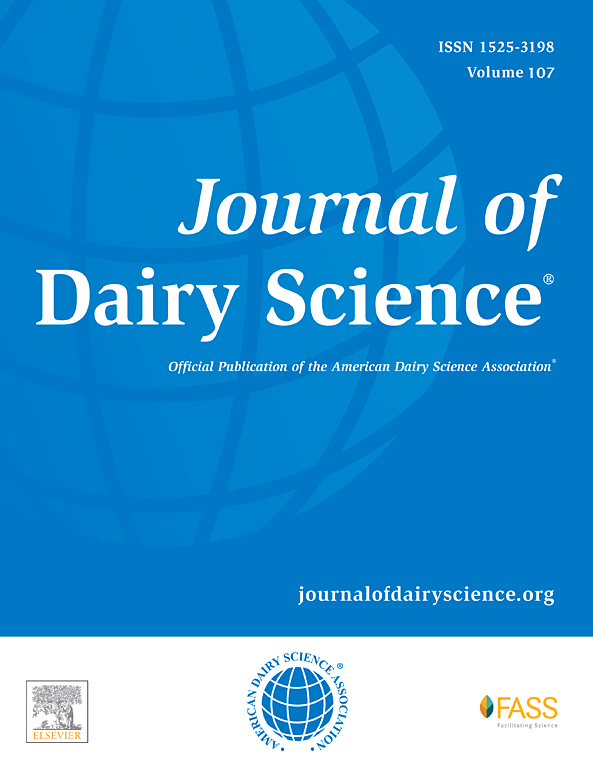All-breed single-step genomic best linear unbiased predictor evaluations for fertility traits in US dairy cattle
IF 4.4
1区 农林科学
Q1 AGRICULTURE, DAIRY & ANIMAL SCIENCE
引用次数: 0
Abstract
The US dairy cattle genetic evaluation is currently a multistep process, including multibreed traditional BLUP estimations followed by single-breed SNP effects estimation. Single-step GBLUP (ssGBLUP) combines pedigree and genomic data for all breeds in one analysis. Unknown parent groups (UPG) or metafounders (MF) can be used to address missing pedigree information. Fertility traits are notably difficult to evaluate due to low heritabilities, changing management, and a higher recent emphasis on selection to move in a favorable direction. We assessed bias, dispersion, and accuracy of fertility traits in all-breed US dairy cattle using pedigree-based BLUP (PBLUP) and ssGBLUP with UPG or MF; with 5% or 10% residual polygenic effect. Validation methods included the linear regression method and comparison of early and late deregressed proofs for Holstein and Jersey breeds. By comparing MF or UPG in PBLUP, we observed similar results in terms of bias, dispersion, and correlations between early and recent predictions. When genomics was used, ssGBLUP with MF and 10% residual polygenic effect consistently outperformed other models regarding bias, dispersion, and correlations. Compared with multistep results, ssGBLUP with MF and 10% residual polygenic effect showed less bias and increased correlations but slightly overdispersed estimates. Overall, genomic prediction of fertility traits using ssGBLUP was accurate and unbiased, more so with MF than with UPG.
美国奶牛育性性状全品种单步GBLUP评价。
美国奶牛遗传评估目前是一个多步骤的过程,包括多品种传统的BLUP估计,然后是单品种SNP效应估计。单步GBLUP (ssGBLUP)在一次分析中结合了所有品种的血统和基因组数据。未知父组(UPG)或元创建者(MF)可用于解决缺失的谱系信息。由于低遗传力、不断变化的管理以及最近更强调向有利方向发展的选择,育性性状尤其难以评估。我们使用基于家系的BLUP (PBLUP)和带有UPG或MF的ssGBLUP评估了全品种美国奶牛生育性状的偏倚、分散和准确性;残余多基因效应(RPE)为5%或10%。验证方法包括LR(线性回归)法和荷斯坦和泽西品种早期和晚期去压力证据的比较。通过比较PBLUP中的MF或UPG,我们在早期和近期预测之间的偏差、分散和相关性方面观察到类似的结果。当使用基因组学时,具有MF和10% RPE的ssGBLUP在偏倚、分散和相关性方面始终优于其他模型。与多步骤结果相比,具有MF和10% RPE的ssGBLUP显示出较小的偏差和增加的相关性,但略有过度分散的估计。总体而言,使用ssGBLUP对生育性状的基因组预测是准确和公正的,与UPG相比,MF更准确。
本文章由计算机程序翻译,如有差异,请以英文原文为准。
求助全文
约1分钟内获得全文
求助全文
来源期刊

Journal of Dairy Science
农林科学-奶制品与动物科学
CiteScore
7.90
自引率
17.10%
发文量
784
审稿时长
4.2 months
期刊介绍:
The official journal of the American Dairy Science Association®, Journal of Dairy Science® (JDS) is the leading peer-reviewed general dairy research journal in the world. JDS readers represent education, industry, and government agencies in more than 70 countries with interests in biochemistry, breeding, economics, engineering, environment, food science, genetics, microbiology, nutrition, pathology, physiology, processing, public health, quality assurance, and sanitation.
 求助内容:
求助内容: 应助结果提醒方式:
应助结果提醒方式:


